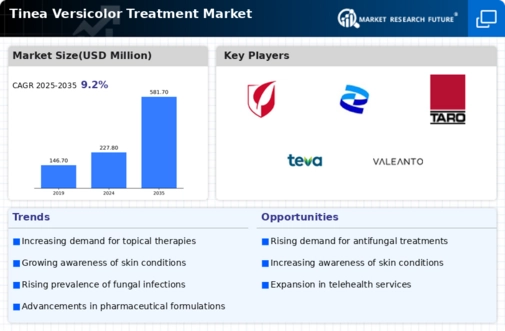Advancements in Treatment Options
Innovations in treatment modalities significantly influence the Global Tinea Versicolor Treatment Market Industry. New antifungal agents, topical therapies, and combination treatments are emerging, enhancing efficacy and patient compliance. For example, the introduction of novel formulations that improve skin penetration and reduce side effects has gained traction among healthcare providers. These advancements not only offer better outcomes but also cater to diverse patient needs, thereby expanding the market. The anticipated growth trajectory suggests that by 2035, the market could reach 581.7 USD Million, reflecting the impact of these innovations.
Increased Awareness and Education
Growing awareness regarding skin health and the importance of early treatment for conditions like Tinea Versicolor plays a crucial role in the Global Tinea Versicolor Treatment Market Industry. Educational campaigns by health organizations and dermatology associations aim to inform the public about symptoms and available treatments. This heightened awareness encourages individuals to seek medical advice sooner, leading to increased demand for effective therapies. As a result, the market is likely to experience a compound annual growth rate of 8.9% from 2025 to 2035, indicating a robust response to educational initiatives.
Rising Prevalence of Skin Disorders
The increasing incidence of skin disorders, particularly Tinea Versicolor, drives the Global Tinea Versicolor Treatment Market Industry. Factors such as urbanization, changing lifestyles, and environmental influences contribute to this rise. For instance, the prevalence of Tinea Versicolor is notably higher in tropical and subtropical regions, where humidity levels favor fungal growth. This trend is expected to escalate, with the market projected to reach 227.8 USD Million in 2024. As awareness of skin conditions grows, more individuals seek effective treatments, further propelling market expansion.
Regulatory Support and Market Accessibility
Supportive regulatory frameworks and improved market accessibility are pivotal for the Global Tinea Versicolor Treatment Market Industry. Governments and health authorities are increasingly recognizing the need for effective dermatological treatments, leading to streamlined approval processes for new therapies. This regulatory support facilitates quicker market entry for innovative products, enhancing competition and consumer choice. Furthermore, initiatives aimed at improving healthcare infrastructure in underserved regions may expand access to treatments, thereby fostering market growth. The combination of these factors is likely to create a favorable environment for sustained industry development.
Rising Disposable Income and Healthcare Spending
The increase in disposable income and healthcare expenditure in various regions contributes to the growth of the Global Tinea Versicolor Treatment Market Industry. As individuals gain more financial resources, they are more inclined to invest in healthcare services and dermatological treatments. This trend is particularly evident in emerging economies, where rising living standards correlate with increased spending on health and wellness. Consequently, the market is expected to benefit from this economic shift, with projections indicating substantial growth in the coming years, driven by consumer willingness to pay for effective treatments.















